By Jeffrey A. Rendall, Photos by Jeffrey A. Rendall (with advice from ‘Mr. 59,’ Al Geiberger)
PALM DESERT, CA – For those familiar with golf in the California low desert, it’s all about the houses.
Face it, golf is an attractive draw for those living in the desert – it offers a green grass escape from the intense heat and harsh desert scrub of the natural environment, and presents a recreational distraction for the area’s many retirees and thriving business interests.
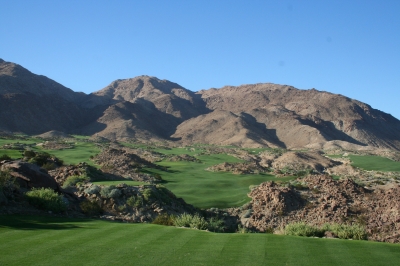 |
| The first tee at Stone Eagle introduces you to what's in store - a golf experience unlike just about anything you've ever encountered. |
As a result, people like to have their homes right beside the cart paths.
So you might find it unusual that there’s a private club in the area with a golf course and no houses bordering the fairways. That’s about as rare as a developable stretch of beach along the Atlantic seashore that doesn’t have some sort of encroaching human habitation.
A lack of residences near the golf course is far from the only unique attraction of the relatively new Stone Eagle Golf Club in Palm Desert. This Tom Doak design (the only one in the area) almost defies description – and it’s not just because of its virtual sense of isolation in such a heavily populated area.
 |
| It doesn't get more majestic than the approach to the par four finishing hole. The smart play is to shoot away from those huge bunkers. |
Stone Eagle’s golf course is set well above the Coachella Valley floor – and when playing, you’re treated to some beautiful scenery on all sides. There are the ‘city’ views down below, but there’re also the surrounding mountains, which makes for an escape in a location where you wouldn’t normally find one.
If you’re lucky enough to visit the club (or be a member), the first question that comes to mind is ‘how could this happen, how is it possible to have a golf facility like this in the California desert?’
Fortunately for us, we have some help in solving the mystery. John Fitzpatrick, Stone Eagle’s Vice President-Project Manager, says it was largely due to the vision of one man. “Ted Lennon (Lowe Destination Development’s President and CEO) knew about the property and developed a relationship with the family who owned the land. Ted is very creative, and he thought this very rugged site could be turned into a fabulous golf club that would complement some of the other wonderful, high-end private communities that featured golf as an amenity.”
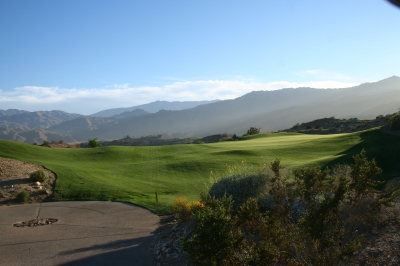 |
| Greenside at the par three 7th hole, the final sunlight of the day illuminates desert vegetation and an attractive green complex. |
“But at Stone Eagle, he wanted to do a pure golf club,” Fitzpatrick said.
Lennon knows golf, having already created The Reserve (amongst others), one of the area’s finest golf developments, which lies within sight of Stone Eagle (and Bighorn is also within a couple tee shots’ distance away).
Glancing at the Stone Eagle’s terrain, you wouldn’t automatically deduce that it’s a natural for golf, as the course itself is situated on a plateau surrounded by steep mountain slopes that could very well double as a ski hill, if snow were plentiful in the region. The property’s rocky nature also wouldn’t necessarily shout ‘golf course here, build me!’ but that’s what Lennon saw, and he had the experience to envision it up there amongst the trails, traverses, desert critters and boulders.
 |
| Looking back from the green of the par five 13th hole. The greens largely slope from front to back at Stone Eagle, adding difficulty to approach shots. |
Once Lennon’s idea was formulated, the creative group needed an architect. But seeing as this wasn’t just any project or any site, the developers were looking for something different. Enter Tom Doak, creator of Pacific Dunes in Oregon and a man with a reputation for stunning visual work in untypical and spectacular settings.
Doak takes the story from here. “The clients were looking for someone who hadn’t worked in the desert before. One of the principals for Stone Eagle, Tom Cullinan, had just been up to Bandon to play Pacific Dunes, and came back thinking they might want to try talking with me.”
It was true, Doak had never worked in the desert, and it also just so happened that he was going to be in Southern California at about the time they were searching for architects, so he could conveniently arrange a site visit.
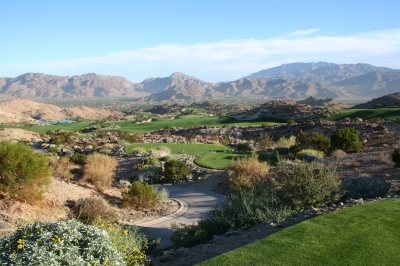 |
| It's all downhill to the par four 9th hole, where you have your choice of a double-decked fairway to choose from. |
“I usually ask to look at a topographic map before I come to see a site, but in this case I was going to be in the area and would just see it first. It’s a good thing – if I’d looked at a map first, I probably would’ve told them the site was too steep. We drove to the site the same way people see it for the first time today (after ascending a steep and lengthy cart road), cresting the hill behind what’s now the 17th tee, and finding a great big bowl of desert terrain up against the mountainside,” Doak remembers.
His reaction was similar to the one you’ll have if you see it. “It was really a ‘Eureka!’ moment. I had a good feeling that we could build something special there, if we could figure out a routing that worked for it,” Doak said.
The length of the climb and the ‘upside down’ nature of the project might have you wondering why they decided to put the golf course up on top, and the houses below (the real estate is at the foot of the slope, just off of Highway 74) – but whatever the reason, it’s good for the golfers. Fitzpatrick said it was Lennon’s idea to put the golf course on top, which would impact the environment the least and create a visually striking experience at the same time.
 |
| The par three 19th hole will settle many a match at Stone Eagle. Al Geiberger calls it the 'prettiest hole in the world without a home.' |
It’ll also never have houses up there -- serene, private golf in perpetuity.
With the ‘vision’ well underway, Lennon then went to the various agencies and environmental groups and laid out what the project would entail. The plan was approved by the City of Palm Desert in 2002, and with Doak under contract, they started moving some rock shortly after.
Once they broke ground, the challenges were just beginning. Again, Doak sheds light on the difficulties: “It was certainly one of the toughest sites we’ve ever built on, due to the steep slopes and rocky terrain, and the need to sift out the rocks to generate our own topsoil for the fairways. From a routing standpoint, the toughest part was figuring out how to keep the golf course in the area it occupies so that we didn’t have to use a less attractive portion of the ground.”
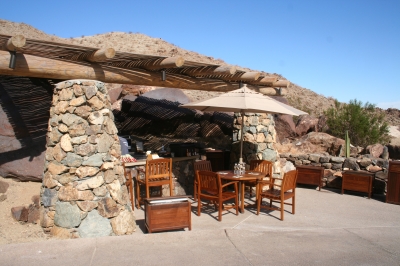 |
| One of many distinctive features at Stone Eagle is the 'Den at Ten,' a taco stand where you can take a few minutes to enjoy the fresh taco of the day, and get ready for the final eight holes of the round. |
Doak continues, “The other challenge was to find a way to take several steeply uphill holes and make them distinctive, and to give the golfer a good impression of the challenges he’s facing on the approach shot when he’s too far below the green to see much of the putting surface.”
Then there were the cart paths. Cart paths? You’d never think finding a place for them would be all that difficult, but on a site like Stone Eagle, truth defies logic. Doak said it was a tremendous challenge to hide the paths in the open landscape, so that when you look across the course your eye is drawn to the golf holes and the desert, not the paths. “My lead associate for the job, Eric Iverson, did a tremendous job of placing the cart paths. Because you can see from one end of the site to the other, he pretty much had to figure out how to hide things from every possible angle.”
You can ‘feel’ the results on the golf course, as the cart paths wind over, down, around and sometimes through some very tricky areas. But it’s all part of the experience. You’ll immediately grasp that this particular piece of ‘rock’ is different. Fitzpatrick said there’s even a legend concerning the site -- that it was once a training ground for Patton’s Third Army during World War II (but they’re not certain about it).
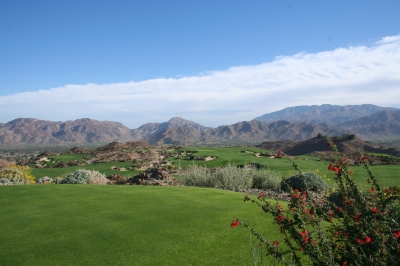 |
| The 352-yard, par four 16th hole is drivable in the right wind conditions, but tempts you to go at it even if the breeze is calm. |
If it’s true, ‘ol Blood and Guts’ men definitely grasped the nature of fighting over tough ground, something that invariably led to victories over equally arduous landscapes in North Africa and Sicily.
Along with golf in this region, there are the environmental questions. Desert environments may not present the appearance of being fragile, but they really are. Part of the Stone Eagle facility falls within the Santa Rosa/San Jacinto Mountains National Monument – so you’ve got compliance issues as well. Bighorn sheep are protected in the area, so there were efforts made to prevent the animals from making their way down to where the golf course would take up residence.
The end result of all the work was satisfying and spectacular. Stone Eagle was ‘unveiled’ in the fall of 2005, and the club’s already garnered a reputation for its unique setting in the Coachella Valley. The biggest question since its opening is just how/where to place it in golf’s endless game of comparisons.
 |
| Looking back from the green of the par four 1st hole. There are no bunkers around the green of this hole, but the grassed slopes around it will test you if you're off the putting surface. |
The comparison question even has the pros stumped. “We’ve had some of the greatest players in the world see and/or play Stone Eagle,” Fitzpatrick mentioned. “Players like Nick Faldo, Ian Baker-Finch, Peter Jacobson, Ken Venturi, Fred Couples, to name a few. When asked to compare Stone Eagle to the courses they’ve seen around the world, very few have said it was like anything in the desert. The simplest way to summarize the comparisons is ‘the Big Island of Hawaii meets the Coast of Scotland.’”
Now there’s a set of comparisons – talk about contrasting environments. But strangely enough, it works well for Stone Eagle. And after reading this, you probably think it’s impossible to actually play golf there – well, it isn’t. Doak made sure the layout was something that people would enjoy on a regular basis.
Doak says while there are a lot of dramatic rock outcroppings near the tees and behind the greens, there’s plenty of room in between to drive your ball, and there aren’t any particularly long carries. The bulk of the challenge comes on the approach shots and around the greens, so players of all levels will find a very manageable golf course – if they can avert their eyes from all the dramatic trouble that shouldn’t come into play if you’re able to focus on the right spots.
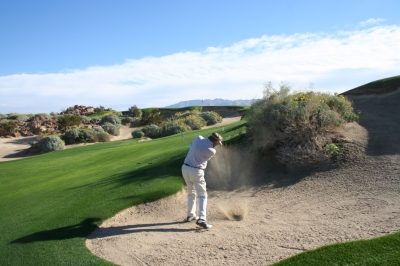 |
| Al Geiberger demonstrates perfect form as he blasts from a bunker - but you'd expect nothing less from 'Mr. 59.' |
Another departure from desert golf – the elevation changes are more akin to the play of a mountain golf course as opposed to the usually dead flat nature of desert links. It’s a trip to the mountains without the windy roads, and that’s a relief.
As fortune would have it, the golf course’s many attributes were vividly presented to me by Stone Eagle’s Professional Emeritus and goodwill ambassador, none other than ‘Mr. 59,’ Al Geiberger. Geiberger’s a long-time resident of the desert, and was gushing in his praise of Stone Eagle, calling it the most unique golf experience in the region.
Geiberger hasn’t lost an ounce of his playing ability, either, though he says he’s not playing much on the Champions Tour anymore. When you can relax and enjoy the gifts of Stone Eagle on a regular basis, I can see where the ‘fishbowl’ inside-the-ropes environment wouldn’t seem as attractive.
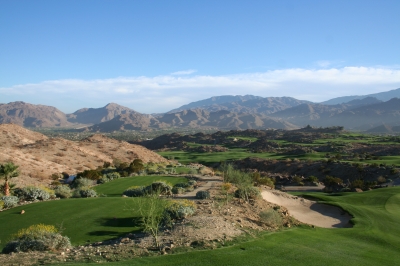 |
| Off the tee of the long par four 4th hole - it looks like there's a lot of trouble, but in reality there's more than enough room to drive the ball. |
Playing the course is golf at its finest. Fitzpatrick describes it: “The course isn’t overly long from any of the tees, and it’s very wide open, much more so than most desert courses which are usually hemmed in by houses. You can hit it a mile wide and you might still be on a fairway (even if it’s a different hole).”
Fitzpatrick says Doak was very conscious of ‘recovery’ play when laying out the holes at Stone Eagle, and as a result, the course is very forgiving. Average players can get around the course by playing to the safe side – and there’s a choice on nearly every hole. There also isn’t any heavy rough around the greens, which presents any number of options on how to play towards the hole if you miss the putting surface. The short-cut nature of the grass around the greens is a fair contrast to many other desert courses which require wedges from wiry rough.
Good players trying to make a score must take into account the layout’s elevation changes, combined with the visual challenges created by the massive scale of the course. The elevation changes aren’t wild, but they are enough to impact your depth perception and distance control. Naturally, it takes a few times for a good player to figure out the correct amount to add or subtract from club distances.
 |
| Tom Doak does a masterful job of lining up the course's features with the surrounding environment. Here's a look at fairway bunkers leading up the canyon on the par four 2nd hole. |
The greens are also subtly challenging. “There are some obvious hints on how to read them, provided by the mountains and the valley, but that’s just the beginning of the equation,” Fitzpatrick explained. “There are a lot of subtle nuances and internal contours in the greens that Tom Doak managed to incorporate that usually take some acquired knowledge to figure out.”
This fact was confirmed by Geiberger, who even had a greens slope-reading device that proved that looks can often be deceiving. He wasn’t the first to shoot 59 in a PGA Tour event by accident.
Other unique aspects at Stone Eagle include the ‘Den at Ten,’ a little taco stand at the top of the ‘mountain’ where you can enjoy a hand-cooked taco before taking on the rest of the back nine. Then, upon finishing up the round, there’s the nineteenth hole (yes, a real golf hole), a beautiful little par three that will leave a lasting impression of the club in your mind.
 |
| The view from behind the 18th green reminds you of why you want to come and play Stone Eagle again. |
Geiberger calls it “the prettiest hole in the world without a home.”
We’ll give Fitzpatrick the next to the final word. “Stone Eagle is a constant learning experience, because of the design of the greens and the variety around them, as well as the subtle and in some cases not-so-subtle movement in the fairways, the risk/reward options throughout the course and all the different elevations. You’ll never play the same course twice – it’s a great members’ course.”
Stone Eagle is just a fantastic golf club, period. It’s a shame that it’s not accessible to the millions of visitors to the region every year, but there’s something to be said for reserving your own little slice of golf paradise for a group of members who can truly learn about and appreciate the gift they’ve been given – and can experience it anytime they want.
Details:
Stone Eagle Golf Club
Phone: 760-773-6223
FAX: 760-773-6224
Website: http://www.stoneeagleclub.com/html/flash.html
Course Designer: Tom Doak
President and CEO: Ted Lennon
Vice President/Project Manager: John Fitzpatrick
PGA Professional Emeritus: Al Geiberger, aka ‘Mr. 59’
Director of Golf: Bill Feil, PGA
Head Professional: Rick Downes, PGA
Tees/Yardage/Slope/Rating
Back 6840 136/72.5
Eagle 6517 132/71.0
Middle 6336 132/70.1
Arroyo 5409 131/72.6
Forward 5112 124/70.7
Membership information:
Stone Eagle is a private golf club, offering an attractive array of individual memberships by invitation to qualified applicants, ranging in price from $50,000 to $175,000. The options include a junior membership for 45-and-under, a non-resident membership.
Real estate ownership is not a requirement of membership.
Club Amenities and real estate:
Stone Eagle’s amenities include a complete golf practice range and short-game area, a stunning par-3 19th hole for settling matches, and a spectacular mountaintop bar and grill known as The Aerie.
Stone Eagle is just minutes from the
More than just an extraordinary golf club, Stone Eagle’s 44 luxury-home residential enclave - known as The Retreat - features a serene desert sanctuary carved into the dramatic canyons below the golf course. Rustic yet elegant, the organic architecture of Stone Eagle’s facilities and residences gracefully complement the club’s natural environment.
Homesites are nestled among picturesque canyons and arroyos, and come complete with construction plans for residences ranging from 2,600 to 3,800 square feet. Alternatively, Ministrelli Homes, a highly respected luxury homebuilder in the
In addition, Stone Eagle recently commenced construction on The Residence Club at Stone Eagle. The private residence club offering complements Stone Eagle’s highly acclaimed private golf club and residential enclave located in Palm Desert, Calif.
The Residence Club at Stone Eagle is located just steps from the clubhouse site and offers non-resident members and their guests the opportunity to stay within the confines of the club without having to purchase a full ownership residence. It consists of three fully furnished casitas, including two 2-bedroom and one 4-bedroom residence, and a private pool available exclusively for owners.
Pricing for an ownership interest in a two-bedroom casita at The Residence Club starts in the high $200s. For a four-bedroom casita, pricing for an ownership interest starts in the high $400s.
| Related Links | Comments on this article? | |
|
Maryland National Golf Club Hollow Creek Golf Club Rocky Gap Resort PB Dye Golf Club in Ijamsville Whiskey Creek Golf Club |
E-mail Jeff Rendall, Editor: jrendall@golftheunitedstates.com |











